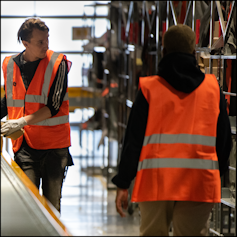Source: The Conversation (Au and NZ) – By Sanjoy Paul, Associate Professor, UTS Business School, University of Technology Sydney
To hear the Woolworths and Coles chief executives speak on Four Corners this week, you’d think their industry was highly competitive.
For instance, Woolies’ chief Brad Banducci said:
this community over here, there will be three Coles stores within two kilometres of it, at least one ALDI store, a series of independents, ability to within 24 hours have a quarter of our store delivered by Amazon – it’s an incredibly competitive market
Meanwhile, Coles’ chief Leah Weckert said:
there are quite often comparisons that are made between the UK and Australia, but Australia has about a third of the population, and we operate stores on a geographic footprint 30 times the size, those considerations need to be taken into account
Between them, Coles and Woolworths control 65% of Australia’s grocery market. Aldi has just 10%, and independents such as IGA have the rest.
Four Corners reported that meant that, on average, for every $10 Australians pay for groceries, $6.50 is spent at Coles and Woolworths, and just $1 at Aldi. In the United Kingdom, there are five major chains vying for a cut of that $10.
But having a large market share isn’t the same as unreasonably using it.
This week’s Four Corners set out eight ways in which Coles and Woolworths are said to use their market power, each of which will be examined by the Australian Competition and Consumer Commission’s inquiry into supermarkets.
Many hurt their suppliers more than their customers.
1. Squeezing farmers
Hundreds of farmers have little choice but to sell their crops to the big two, and little choice but to accept whatever is offered.
One cherry farmer sent 15 tonnes of cherries to Coles – an entire semi-trailer load. He hoped to receive A$90,000.
Instead, he was told the fruit was not up to standard and was only able to get $5,800 on the seconds market.
He said when Coles is dealing with thousands and thousands of pieces of fruit, it can pick out ten pieces and say the consignment is no good.
so that is power, that’s market power when you can simply reject something for no great reason
The behaviour described might amount to “misuse of market power” under the Competition and Consumer Act 2010.
2. Demanding money to accept price increases
Four Corners told the story of a supplier who asked to be paid 5% more and was told the request would be approved only if he paid Coles A$25,000.
The lump sum was for promotions.
It said the Coles buyer’s initial desire to keep prices low for the consumer had been “quickly forgotten”.
The supplier said if he wasn’t prepared to do what the supermarket wanted, there was “a lot of intimidation”.
The tools used included deleting suppliers’ products from sale, forcing customers to buy their competitors’ products.
While this behaviour appears not to be illegal, it might worry the Australian Competition and Consumer Commission.
3. Charging for Coles Radio
Four Corners said suppliers wanting to do business with the big two were asked to pay for in-house advertising.
It quoted the cost of a full-page ad in Woolworths’ Fresh Magazine at $30,000, and the cost of a four-week spot on Coles radio at $28,000.
Suppliers were also expected to meet the cost of special discounts rather than the supermarket. That means suppliers need to set their recommended retail price at a higher level than was needed in order to offer periodic discounts.
While quite legal, this behaviour has the effect of forcing up general prices. It would be illegal if it misrepresented ordinary prices.
4. Matching prices

Shutterstock
The supermarket giants monitor each other’s pricing very closely. If one changes its prices, the other follows.
A former category manager for Coles and Woolworths said if one put up a price, the other would quickly follow.
He said if you did five shops in Woolworths and five in Coles and spent around a hundred dollars, there would only be a few cents difference.
The behaviour might be the result of intense price competition of the kind the Commission wants to encourage, or it might be the result of an implicit understanding between the big two not to compete on price, something the Commission will be keen to determine.
5. Blaming inflation
Woolworths’ latest annual report shows its cost of doing business was flat, but its profit margin from selling groceries climbed from 5.3% to 6%, which meant an extra $318 million in profits.
An industry insider told Four Corners that the big two used “the cover of inflation” to raise prices, something each denied.
Woolworths said its price increases were legitimate, pointing to increases in the price of fertiliser, international freight, wages, and the cost of disruptions in obtaining goods.
Even if unjustified, there is nothing illegal about raising prices, unless false representations are made about the reasons, which is something the Commission will want to examine.
6. Banking land
An industry insider told Four Corners the big two buy up “spoiler sites” years before they even get approvals to build.
If they get the green light, it’s a new supermarket. If not, they’ve kept their rivals out.
In one growing community west of Brisbane, Woolworths bought more than 6 hectares of land over 11 years. But a supermarket is still years away.
German supermarket giant Kaufland abandoned plans to enter the Australian market in 2020. Media reports said a lack of suitable sites was one factor.
The Commission would be hard-pressed to find such behaviour was illegal unless it was able to make a case that it significantly lessened competition.
7. Dark stores

Shutterstock
Delivery and click-and-collect orders sometimes come from “dark stores” without customers in which stock pickers work at speed in what can be stifling heat.
“There is an industry standard of a pick rate of about 180 items per hour,” one stock picker said. “Our warehouse, particularly during busy periods, will push you to go above and beyond that, which might be 210, 220.”
In the past, the names of pickers who fell behind were displayed in red.
Every summer there’s people who feel dizzy, every summer there’s people whose sweat’s just dripping off them and they want to sit down, but you get a 15-minute break in a five-hour shift
While not infringing on competition law, such behaviour might breach industrial laws. The Commission is likely to find it beyond the scope of its inquiry.
8. A conduct code with no penalty
Former Australian Competition and Consumer Commission Chairman Rod Sims, described the Food and Grocery Code of Conduct as a “joke” because it had no penalties.
He said it was like having a speed limit of 60 kilometres an hour with no penalty for driving at 80.
Woolworths conceded it hadn’t received a single complaint under the grocery code of conduct in the past year. Asked why, chief executive Brad Banducci said Four Corners should ask suppliers.
Only one continuing supplier agreed to appear in the program on the condition that the appearance was anonymous.
The Commission is certain to recommend that the code be given teeth.
Over to the Commission
The Competition and Consumer Commission’s investigation is likely to confirm that Australian supermarkets have some of the highest profit margins in the world, deriving in large part from their high market share.
At issue will be what this enables them to do to their suppliers and customers.
The Commission will publish an issues paper this month and report to the government in August.
Read more:
Why prices are so high – 8 ways retail pricing algorithms gouge consumers
![]()
Sanjoy Paul does not work for, consult, own shares in or receive funding from any company or organisation that would benefit from this article, and has disclosed no relevant affiliations beyond their academic appointment.
– ref. 8 ways Woolworths and Coles squeeze their suppliers and their customers – https://theconversation.com/8-ways-woolworths-and-coles-squeeze-their-suppliers-and-their-customers-223857








